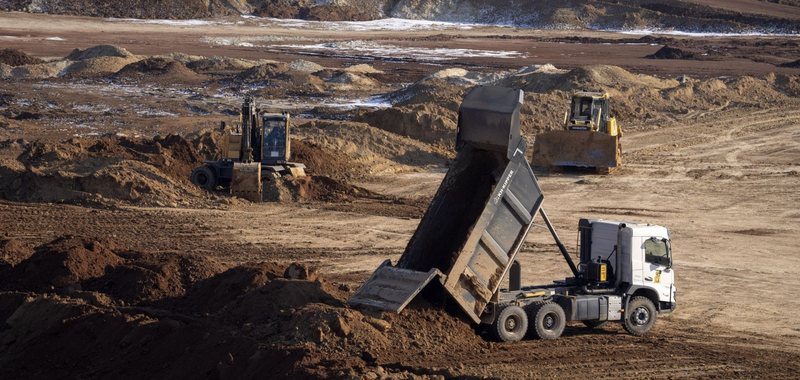Artificial Intelligence Builds the Homes of the Future - Can Robotics Solve Britain's Housing Crisis?

Giant robotic arms controlled by artificial intelligence move elegantly in a large factory in Oxfordshire, England, building housing frames from wood, one of the world's oldest building materials.
With the British government committed to building 300,000 new homes each year, some builders believe that combining technology with green materials like wood could help them meet challenges such as labor shortages and environmental targets.
The country has lagged behind other similar economies in the use of wood for house construction. Meanwhile, Britain as a whole is one of the countries with the lowest uptake of robotics in construction, according to the National Robotarium research institute at Heriot-Watt University.
“We’re seeing more and more builders, large and small, using wood as a way to overcome labor and carbon emissions challenges,” said Alex Goodfellow, CEO of Donaldson Timber Systems. His company manufactures wooden home and commercial building structures, including walls, floors and roofs, which are then shipped to builders for assembly.
According to the company, automated production requires less manual labor and offers a faster, cheaper and more durable alternative to bricks, stones or concrete blocks. A study by construction consultancy Rider Levett Bucknall shows that building with wood is 2.8% cheaper than building with masonry.
Faster construction
The factory near Oxford in southeast England produces wood panels for around 100 homes a week. Designs are entered into the system digitally using artificial intelligence.
The company says its robots and lasers enable the production of prefabricated sections that can be quickly assembled on site. The technology cuts the construction time of a house by around 10 weeks compared to traditional methods. However, there are still obstacles to a significant increase in the use of wood in construction in England. Experts argue that the material is not widely used, due to concerns about its sustainability.
However, the Structural Timber Association says these concerns have been addressed through modern building regulations and new fire safety guidelines. It says the sector could contribute around a third of the government’s target of 300,000 homes a year, a level not reached in England since the 1970s. The figures show that around 200,000 new homes were built in the country in 2023/24, and around 40,500 of these were timber-framed houses.
Greener and lighter?
In addition to efficiency, Bellway emphasizes the environmental benefits of wood. According to them, wood absorbs and stores more carbon than it emits. The company's analysis shows that concrete blocks are among the biggest polluters in construction.
However, the origin of raw materials remains a challenge. Around 80% of the timber used in the UK comes mainly from European countries, while only around 20% of bricks are imported. Meanwhile, the ageing workforce highlights the need to increase the presence of robots. Around 20% of construction workers in the UK are over 50, and 25% of them are expected to retire in the next decade.
In June, the government pledged £40m for robotics technology centres across sectors, but economists say construction in Britain lags far behind other countries in the use of robots. By 2023 there will be 1.5 robots for every 10,000 construction workers in Europe, compared with 0.6 in the US and just 0.5 in Britain.
In addition to replacing manual labor, robotics can also open up new job opportunities, said Frank O'Reilly, head of Donaldson Timber Systems. After incorporating robotics into the factory, the company has attracted more young people who are passionate about technology. "This technology encourages young people to see construction as a future career," he added.

How developed is Albania in digital skills? - RCC: Our businesses surpass those of the EU in social media marketing
Albania surpasses the Western Balkans and Europe in the number of graduates in Information and Communication Technology, in relation to the total of all......

US "fearful" of dependence on critical minerals - About $1 billion in funding to boost domestic production
Critical minerals and materials are essential to modern technology and industrial development, playing a key role in areas ranging from renewable energy to......

The fire situation in the country is improving - 57 fires have been reported in the last 24 hours, of which 29 are active
The Ministry of Defense reports that the fire situation in the country is more stabilized today. Over the last 24 hours, 57 fires have been reported, of......

Family debts to OSHEE, over 44 billion lekë - Reliefs/ New installment repayment scheme implemented, businesses also benefit
The Electricity Distribution Operator began implementing new agreements on July 21 for the installment payment of outstanding obligations until December 31,......

Fire figures, Albania far from regional records // Bosnia and Herzegovina and Montenegro, the most affected in the last decade
Data from the European Forest Fire Information System for the period 2015–2025 show that Albania has lost about 233 thousand hectares to fires, less than......

The US Dollar and the British Pound Strengthen - How Much the Major Currencies Are Exchanging Today!
The US dollar strengthened this morning, being bought today at 82.4 lek and being sold at 83.7 lek compared to the previous day according to the local......

Bitcoin reaches new record - Reason, expectations for interest rate cuts and supportive policies
Bitcoin hit a record high on Thursday as rising expectations for easier monetary policy from the Federal Reserve added support, along with recently announced......

Appeals Court Gives Trump the Green Light - Allows Government to Cut Off Billions of Dollars in Foreign Aid
A U.S. appeals court has upheld the Trump administration's decision to suspend or cut billions of dollars in foreign aid funding approved by Congress, seven......




















